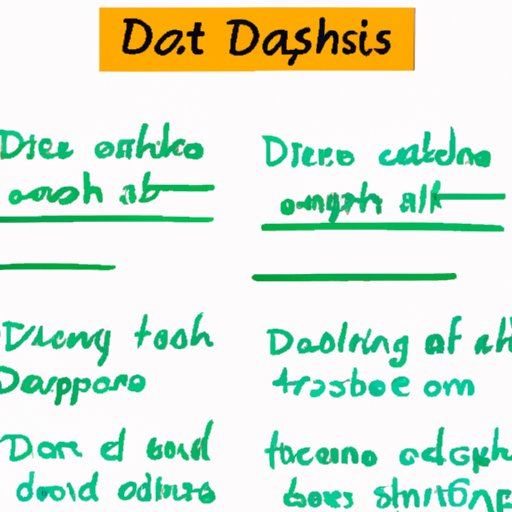Introduction
Dashes are one of those punctuation marks that many writers struggle to use correctly. These long horizontal lines can be used in different ways, but their misuse can lead to confusion or ambiguity in a sentence. If you want to improve your writing skills, learning how to use dashes correctly is a must. In this article, we’ll explore the different types of dashes and ways to identify correct placement, as well as common dos and don’ts of using them.
A Quick Guide to Mastering Dashes: Spotting Correct Usage in a Sentence
Dashes are horizontal lines that are longer than hyphens and are used to set off elements in a sentence. There are three types of dashes: the hyphen (-), the en dash (–), and the em dash (—).
The hyphen is used to join compound words, such as “well-being” or “mother-in-law.” It is also used to separate syllables when a word is split between lines.
The en dash is slightly longer than the hyphen and is used to indicate a range of values, such as “pages 10–15” or “June–September.”
The em dash is the longest dash and is used to set off a phrase or to emphasize or interrupt a sentence. For example, “The teacher—frustrated with the lack of participation—decided to change the lesson plan.” The em dash can be used in place of commas, parentheses, or colons to create a stronger break in the sentence.
It’s important to note that some style guides recommend putting a space before and after an en dash, while others do not. The em dash is usually not spaced in American English, but some British English style guides suggest putting a space before and after it.
When using dashes, it’s important to avoid overusing them. Dashes should be used to clarify or add emphasis to a sentence, not to replace other punctuation marks. Before using dashes, consider whether commas, parentheses, or colons could be used instead.
The Art of Using Dashes in Writing: Examples of Correct Placement
Let’s look at some examples of correct dash usage in different types of sentences.
Adding Information: Dashes can be used to add information to a sentence that is not essential but provides extra context. For example: “The toddler—wearing a blue sweater—was playing in the park.”
Creating Emphasis: Dashes can be used to emphasize a phrase or a word within a sentence. For example: “I told you to be here at 8:00—eight o’clock sharp!”
Changing Tone: Dashes can be used to change the tone of a sentence. For example: “I can’t believe he—of all people—would do something like that.”
When using dashes to add information or emphasize a sentence, it’s important not to overuse them. Too many dashes can confuse readers and make your writing look cluttered.
The Dos and Don’ts of Dashes: How to Identify Correct Usage in Writing
One of the most common mistakes writers make when using dashes is confusing them with hyphens or using them to replace other punctuation marks.
Hyphens are used to join words together, such as “self-esteem.” Using a hyphen instead of an en dash to indicate a range of values or an em dash to emphasize a phrase can lead to confusion.
Replacing commas, parentheses, or colons with dashes can also create ambiguity in a sentence. If you’re not sure whether to use a dash or another punctuation mark, consider what effect you want to achieve in the sentence and whether a dash would enhance or detract from that effect.
To use dashes correctly in writing, it’s essential to be consistent in your use and placement of them. If you use an en dash to indicate a range of values in one sentence, use an en dash consistently throughout the rest of the document. If you use an em dash to interrupt a sentence, use it consistently for similar interruptions.
Dash Your Writing Woes Away: Tips for Using Dashes with Precision
To improve your dash usage in writing, consider these tips:
Read widely: Take note of how other writers use dashes in their work and what effects they achieve.
Practice: Experiment with using dashes in different types of writing, such as academic writing, creative writing, or business writing.
Use resources: Consult style guides or websites on punctuation to learn more about correct usage and common mistakes.
Get feedback: Ask a colleague or a writing tutor to review your work and provide feedback on your dash usage.
By practicing and refining your use of dashes, you can enhance your writing and make it more effective.
Getting Dashing with Your Writing: Correct Placement of Dashes in Sentences
Using dashes correctly can take some practice, but mastering them can elevate your writing to a new level. Remember to use dashes sparingly and only when they enhance the meaning or tone of a sentence. Before using a dash, consider whether another punctuation mark may be more suitable.
As a final example, consider this sentence: “She opened the door—slowly, cautiously—to see what was inside.” The em dash interrupts the sentence to create emphasis on how she opened the door, while the commas set off the adverbs describing how she opened it.
Conclusion
Dashes can be a powerful tool in a writer’s arsenal, but only if used correctly and with precision. By understanding the different types of dashes and their correct usage, you can make your writing more effective, enhancing clarity and style. Remember to practice your dash usage and seek feedback to improve your skills. The next time you’re dashing off a sentence, think about how a well-placed dash can enhance your meaning and impact.
